When I first posted statistical projections for the 2018 NBA draft back in March, I included only those for college prospects, which left a Luka Doncic-sized hole at the top of the rankings.
Now that we're including everyone, Doncic is naturally No. 1, and his 5.8 projected wins above replacement player (WARP) -- what we'd expect him to average over his first five seasons, discounting more distant ones to reward immediate returns -- are in fact the most for any of the 800-plus players I've projected dating back to 2003. Doncic tops Anthony Davis (5.5) for that honor, though it's worth noting that I don't have a projection for LeBron James out of St. Vincent-St. Mary High School or Dwight Howard the following year.
Doncic's ascension to the top isn't the only change since March. Like our ESPN Analytics projections, I've incorporated performance in the Nike EYBL AAU league for players who saw action there in either 2015 or 2016 thanks to Neil Johnson of ESPN Stats & Information. This has a significant impact for freshmen who often played nearly as many minutes in the EYBL as in the NCAA -- or many more, in the case of Michael Porter Jr., who missed most of his lone season at Missouri due to injury.
Additionally, as explained in a full piece looking at the value of centers in the modern NBA, I've made an adjustment to the projections based on player positions that causes big men to fall in the rankings and wings, in particular, to climb. As a result, my projections now differ more from the consensus at the top of the draft, which will likely be dominated by big men.
You can read more on the projections and see how they've worked in the past here, but now let's get to the rankings based on consensus projections that incorporate both statistical performance and where the player rates in the current top 100 from Insider Jonathan Givony.
1. Luka Doncic

Real Madrid
PG
Top 100: No. 2
Stats: No. 1
Consensus: 5.8 WARP
Doncic has played nearly 4,000 minutes and counting between the Spanish ACB and the Euroleague -- more than three times as many as Anthony Davis played at Kentucky, for example. As a result, while there's still reason to question how his skills will translate to the NBA, we can be more confident in his projection accurately capturing those skills.
2. Deandre Ayton
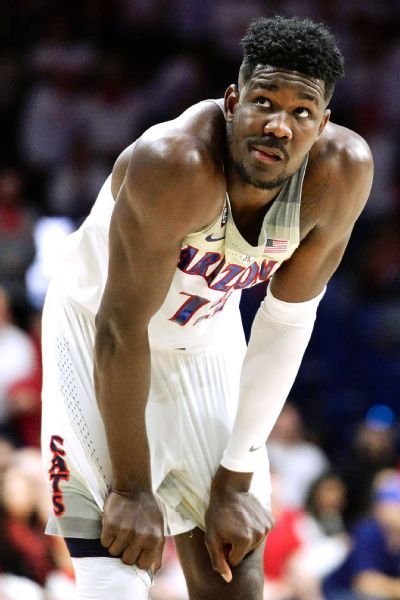
Arizona
C
Top 100: No. 1
Stats: No. 12
Consensus: 3.2 WARP
Before the positional adjustment, Ayton ranked fourth in my stats-only projections, so he takes a major hit.
Still, he looks like a strong prospect. Ayton's projections rank among the top 25 percent of NBA-bound centers in seven categories (usage, 2-point percentage, shooting, rebound percentage, assist percentage, turnover percentage and foul percentage) -- as many as Doncic. The difference is that Ayton's statistical weaknesses (particularly steal percentage, though his block percentage is on the low side for a center) take a bigger hit out of his projection.
3. Trae Young
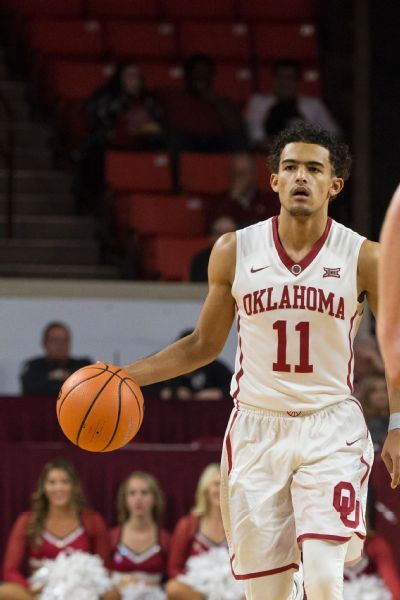
Oklahoma
PG
Top 100: No. 8
Stats: No. 2
Consensus: 3.0 WARP
Young is the biggest beneficiary of the positional adjustment, jumping several of the big men who previously rated ahead of him to finish with the best statistical projection among college prospects. Young's projected usage rate ranks fifth among players in the top 100 of ESPN's draft rankings, and his projected assist rate ranks second behind Doncic.
4. Jaren Jackson Jr.
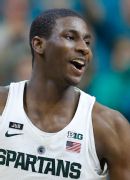
Michigan State
F/C
Top 100: No. 4
Stats: No. 6
Consensus: 2.8 WARP
Jackson was the No. 1 college prospect in March, but both of the changes to the projections hurt him. He wasn't nearly as effective in the 2016 EYBL as during his lone season at Michigan State. Nonetheless, Jackson benefits from being the youngest prospect in the top 100.
5. Michael Porter Jr.

Missouri
SF
Top 100: No. 6
Stats: No. 5
Consensus: 2.7 WARP
In March, Porter wasn't included in my projections because he'd played just two minutes before undergoing back surgery. He returned to play 51 in two tournament games, but his projection is still based primarily on the EYBL. Porter rated as the league's third-most valuable player by WARP in 2016 and performed decently as a rising junior the year before. Assuming Porter's medicals check out -- no sure thing -- he should still be considered the top prospect he was entering Missouri.
6. Mikal Bridges

Villanova
SF
Top 100: No. 14
Stats: No. 4
Consensus: 2.5 WARP
A favorite of statistical projections dating back to when he was coming off the bench as a redshirt freshman, Bridges developed to become the best player on last year's national champions. His game should translate well to a 3-and-D role in the NBA. While Bridges could stand to improve on the defensive glass, his steal rate is solid and he has the ability to defend multiple positions.
7. Mohamed Bamba

Texas
C
Top 100: No. 3
Stats: No. 16
Consensus: 2.5 WARP
One concern about Bamba: his projected assist rate (1.3 per 100 team plays) ranks among the bottom 25 in my projection database. It's possible to become an effective offensive player despite that issue -- fellow Longhorn LaMarcus Aldridge had a weaker assist projection, as did Hassan Whiteside, though Greg Oden and Emeka Okafor were similar -- but it limits Bamba's offensive value.
8. Dzanan Musa
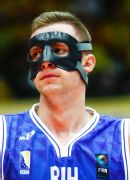
KK Cedevita
SF
Top 100: No. 19
Stats: No. 3
Consensus: 2.4 WARP
At age 18 (he turned 19 in May), Musa was one of the best players in the Adriatic League this past season. The Adriatic has been a cradle for NBA big men, recently producing the likes of Nikola Jokic and Jusuf Nurkic. The track record for wings has been more mixed; though the likes of Bogdan Bogdanovic and Dario Saric played there early in their careers, only Timothe Luwawu has gone directly from the ABA to the NBA in recent memory, and the athleticism of Adriatic wings is limited. That could be an issue for Musa, but he projects as an efficient scorer thanks to accurate shooting both inside and outside the arc.
9. Mitchell Robinson

N/A
C
Top 100: No. 23
Stats: No. 7
Consensus: 1.8 WARP
Along with Billy Preston, Robinson is one of two players in this year's top 100 projected solely based on EYBL performance. He was fourth in the 2016 EYBL in WARP behind Young, Porter and Kentucky point guard Quade Green. Robinson's block rate was the best by any EYBL player in a season from 2012 to 2016, his offensive rebound rate was third in that span, and his 73 percent 2-point shooting was tops among players with at least 150 attempts. We didn't get a chance to see how that play would translate at the NCAA level, but if Robinson can harness his skills, he has a chance to be the steal of this year's draft.
10. Miles Bridges

Michigan State
SF
Top 100: No. 15
Stats: No. 11
Consensus: 1.8 WARP
Bridges could be even better offensively in the NBA with better floor spacing than he enjoyed playing small forward next to Jackson and traditional centers at Michigan State. According to positional splits compiled by Will Schreefer, Bridges averaged 39.6 points per 100 possessions with a .596 true shooting percentage in 412 possessions at power forward, as compared to 29.9 points per 100 possessions and .575 true shooting in 1,403 possessions at small forward. Bridges might have a hard time defending 3s; his projected steal rate (1.0 per 100 team plays) would rank among the bottom 50 perimeter players in my database.
11. Kevin Huerter

Maryland
SG
Top 100: No. 20
Stats: No. 8
Consensus: 1.8 WARP
Huerter is an interesting prospect because he's all strengths and weaknesses. His projections rank in the top 25 percent of NBA-bound shooting guards in five of the 10 categories I track, but in the bottom 2 percent of four of the other five. (Rebound percentage is the one skill that rates as neither a strength nor a weakness for Huerter.) Fortunately, his strengths -- particularly outside shooting -- are more valuable than his weaknesses, though a low steal rate (1.1 per 100 team plays) is also a concern for him.
12. De'Anthony Melton

USC
G
Top 100: No. 24
Stats: No. 10
Consensus: 1.7 WARP
Melton sat out the entire 2017-18 season due to eligibility concerns. A relatively unskilled offensive player who shot 28 percent on 3s as a freshman in 2016-17 and isn't quite a point guard, Melton is valuable nonetheless for his defense; his projected 2.8 steals per 100 plays rank in the top 20 in my database. Melton could be a skinnier Marcus Smart at the NBA level, though Smart was a much higher-usage player in college.
13. Jacob Evans

Cincinnati
G
Top 100: No. 30
Stats: No. 9
Consensus: 1.6 WARP
I'm surprised Evans hasn't gotten more buzz as the draft approaches. He's a modern perimeter player who shot 38 percent on 3s during his college career but also handles the ball well enough to run the Bearcats' offense at times. Evans is also big enough to defend either backcourt spot and some small forwards. A relatively low usage rate might be working against Evans, along with the fact that poor midrange shooting limited his efficiency (he shot 33 percent on 2-pointers beyond 5 feet, per Synergy Sports tracking).
14. Marvin Bagley III
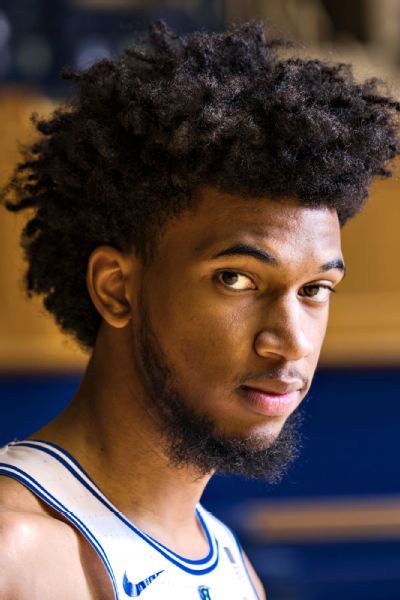
Duke
F/C
Top 100: No. 5
Stats: No. 43
Consensus: 1.5 WARP
Bagley, ranked fifth in March, tumbles because of the two changes to my projection method. Intriguingly, while adding EYBL stats boosted Bagley atop the ESPN Analytics model, incorporating his 2016 performance hurts him here. (Bagley also played in 2017, which is not considered because incoming college freshmen typically don't play AAU ball; Bagley did before reclassifying.) His 58 percent 2-point shooting was relatively unimpressive given the level of play (Ayton, by contrast, shot 65 percent) and Bagley went 8-of-48 on 3s. Based just on his Duke stats, Bagley would rank ninth overall even with the adjustment for positional value.
15. Zhaire Smith

Texas Tech
SF
Top 100: No. 16
Stats: No. 20
Consensus: 1.4 WARP
Smith also was less effective in the EYBL than as a freshman, which makes sense given the way he came out of nowhere as an unranked prospect according to ESPN Recruiting Nation. Smith's steal and block rates were far less eye-popping against AAU competition. Still, the positional adjustment leaves Smith in about the same spot as in the top 100.
16. Elie Okobo

Pau-Orthez
PG
Top 100: No. 21
Stats: No. 18
Consensus: 1.4 WARP
Okobo took a key step forward in the French LNB Pro A this season, nearly doubling his minutes per game and going from 48 points and 1.6 assists per game in 2016-17 to 12.9 and 4.8 apiece. Okobo's projected assist rate is now solidly average for an NBA-bound point guard, and his 3-point shooting (39 percent from the FIBA line last season) is a strength.
17. Robert Williams

Texas A&M
F/C
Top 100: No. 12
Stats: No. 28
Consensus: 1.4 WARP
A classic rim-running big man, Williams could benefit from playing center in the NBA in a four-out system. Per Schreefer's tracking, he shot 74 percent on 72 2-point attempts as a center as compared to 64 percent on 135 as a power forward next to fellow starter Tyler Davis. So the positional adjustment might drop Williams a bit too far.
18. Gary Trent Jr.

Duke
SG
Top 100: No. 39
Stats: No. 13
Consensus: 1.2 WARP
Trent's father and namesake made four 3s during a nine-year NBA career; Trent Jr. made at least four in a game six times last season, shooting 40 percent overall. That drives much of Trent's value, as his assist rate is among the bottom 10 guards in my database, and he shot just 43 percent inside the arc.
19. Wendell Carter Jr.

Duke
C
Top 100: No. 7
Stats: No. 46
Consensus: 1.2 WARP
Even more so than his frontcourt-mate, Carter suffers from the changes to my projection system. Like Bagley, he would rank in the top 10 even with the position adjustment if his EYBL stats were ignored. Highly productive at Duke (his 13.5 box plus-minus rating trailed only Jackson among freshmen who played at least 500 minutes, per Sports-Reference.com), Carter was less effective in AAU competition -- particularly as a rising junior in 2015, when he struggled on the glass.
20. Shai Gilgeous-Alexander
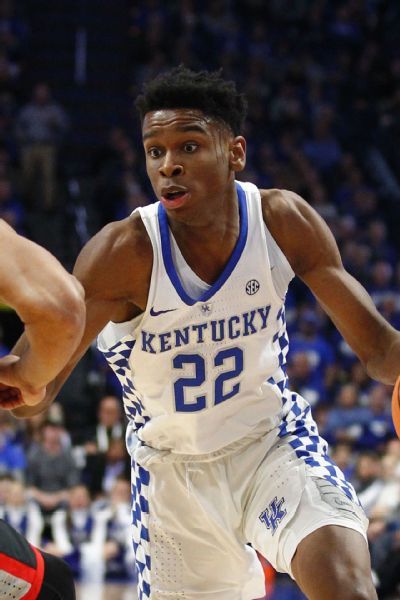
Kentucky
PG
Top 100: No. 10
Stats: No. 37
Consensus: 1.2 WARP
Gilgeous-Alexander's projections don't stand out in either a positive or negative sense. He ranks in the top or bottom 25 percent of NBA-bound point guards in my database in only one of the 10 skills I evaluate: block rate, a strength for him.
21. Lonnie Walker IV

Miami
PG
Top 100: No. 13
Stats: No. 33
Consensus: 1.2 WARP
To live up to the lottery hype, Walker is going to have to find a way to score more efficiently in the NBA than he did as a freshman at Miami, posting a .527 true shooting percentage. Walker rarely got to the free throw line and wasn't an accurate enough shooter inside (49 percent) or outside (35 percent) the arc to make up for that.
22. Collin Sexton

Alabama
PG
Top 100: No. 11
Stats: No. 39
Consensus: 1.1 WARP
Sexton represents one of the bigger points of disagreement between my projections and the ESPN Analytics model, which has him eighth -- ahead of both Porter and Young. His projection suffers here in part because of a below-average steal rate for a point guard, something that was true both at Alabama and in the EYBL.
23. Kevin Knox

Kentucky
SF
Top 100: No. 9
Stats: No. 47
Consensus: 1.1 WARP
Ranked 12th by ESPN Analytics, Knox is another point of contention. His measurables and skill set sound good on paper; in practice, Knox has not rated well either at Kentucky or in two years of EYBL play. Besides scoring, Knox makes little other box-score impact. He can overcome that if he develops into an elite shooter at 6-foot-9.
24. Landry Shamet

Wichita State
PG
Top 100: No. 49
Stats: No. 15
Consensus: 1.1 WARP
Shamet projects slightly ahead of Young as the best offensive player in this draft as a rookie, by virtue of making 56 percent of his 2s and 44 percent of his 3s as a redshirt sophomore. Shamet's defensive indicators are far worse, including a poor steal rate. Whether Shamet can hold up on defense will determine whether he can be more than a solid reserve in the NBA.
25. Troy Brown

Oregon
G/F
Top 100: No. 18
Stats: No. 32
Consensus: 1.0 WARP
There's a lot to like about Brown, who projects with a solid combination of rebound and assist rates and an above-average steal rate. Brown's problem is almost entirely 3-point shooting. Having shot 29 percent on more than three attempts per game at Oregon -- in line with his accuracy in AAU games -- Brown projects with the third-lowest 3-point percentage of anyone in the top 100. (Players with few 3-point attempts get projected primarily based on the average for their position, so Brown comes in behind them.)
26. Josh Okogie

Georgia Tech
SG
Top 100: No. 25
Stats: No. 24
Consensus: 1.0 WARP
A solid 3-point shooter (38 percent both seasons), Okogie made just 43 percent of his 2s as a sophomore, a worrisome indicator for his NBA efficiency. On the plus side, he's the only player in my top 30 who projects in the top 25 percent of NBA-bound players at his position in both steal and block rate.
27. Grayson Allen

Duke
SG
Top 100: No. 27
Stats: No. 23
Consensus: 1.0 WARP
Because of his high volume of 3-point attempts (7.5 per game as a senior) and accurate free throw shooting (85 percent), Allen has the best projection in the top 30 for my shooting rating, which combines 3-point attempts, percentage and free throw percentage.
28. Kevin Hervey

Texas Arlington
F
Top 100: No. 46
Stats: No. 17
Consensus: 1.0 WARP
With his size and defensive rebounding, Hervey should be capable of playing power forward in the NBA, which gives him the potential to emerge as a stretch 4. He attempted nearly seven 3s a game as a senior, though his 34 percent accuracy (32 percent career) was subpar.
29. Donte DiVincenzo
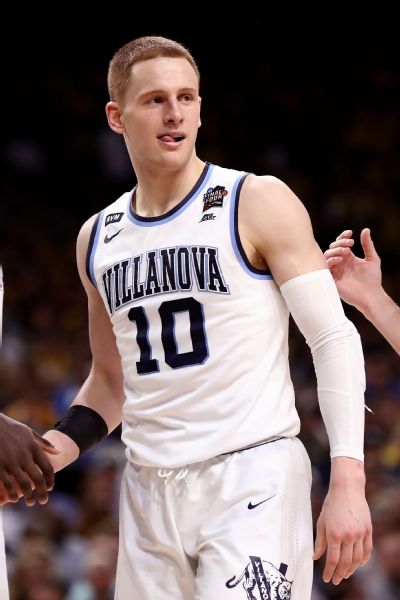
Villanova
PG
Top 100: No. 26
Stats: No. 26
Consensus: 1.0 WARP
DiVincenzo's potential as a scorer is intriguing because he's an excellent finisher thanks to his athleticism (57 percent career on 2s) and also a good enough shooter to be a threat outside the arc (40 percent on 3s last season, 38 percent career).
30. Kenrich Williams
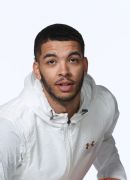
TCU
SF
Top 100: No. 63
Stats: No. 14
Consensus: 1.0 WARP
The lowest-ranked player in the top 100 to crack my top 30, Williams will be 24 in December (he was a fifth-year senior because microfracture knee surgery cost him the 2015-16 season). Despite a severe penalty for age, Williams still rates as a strong prospect because of his versatility. He's a phenomenal rebounder for a wing who has also developed into an above-average playmaker and shot nearly 40 percent from 3-point range last year. Williams also ranks 34th in the ESPN Analytics model, so while his age might limit his upside, he looks like a solid pick early in the second round for a team looking for immediate contributions.
Full 2018 NBA draft rankings
Top-100 players without statistical projections:
Anfernee Simons
Rodions Kurucs
Issuf Sanon
Isaac Bonga
Tryggvi Hlinason
Herve Kabasele Kasonga
